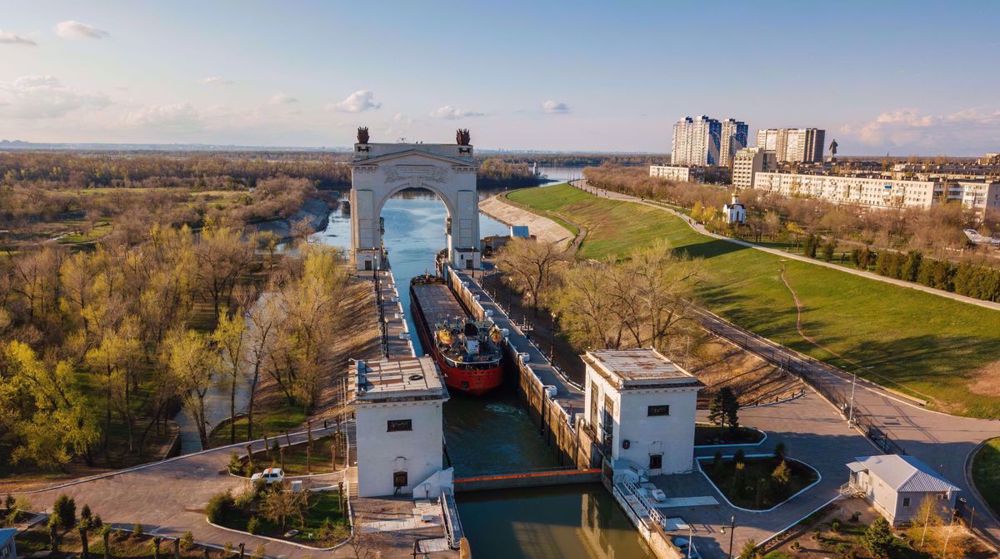
Historically tinged by an undercurrent of distrust and wariness, ties between Iran and Russia have metamorphosed into an alliance where the two countries are increasingly finding in each other lifelines for their sanctions-hit economies.
The war in Ukraine and ensuing global sanctions on Moscow have prompted Russia to put aside its ambivalence about deepening relations and forging economic and trade partnership with Iran.
This change of heart has unleashed an unprecedented drive to build up new trade networks through river and railway links.
This month, Russian President Vladimir Putin and his Iranian counterpart Ebrahim Raeisi oversaw, via video-link, the signing of a deal to finance and build an Iranian railway line as part of the international North–South Transport Corridor.
The Rasht-Astara railway is seen as an important link in the corridor, intended to connect India, Iran, Russia, Azerbaijan and other countries via railways and sea - a route that Russia says can rival the Suez Canal as a major global trade route.
Putin said the 162 km railway along the Caspian Sea coast would help to connect Russian ports on the Baltic Sea with Iranian ports in the Indian Ocean and the Persian Gulf.
For the purpose, Iran and Russia are spending billions of dollars on a 3,000–kilometer passage that stretches from the eastern edge of Europe to the Indian Ocean, along rivers and railways linked by the Caspian Sea.
At its northern end is the Sea of Azov which in Putin’s words “has become an inland sea” for Russia. It is bracketed by the Crimean Peninsula and the mouth of the River Don. From there, river, sea and rail networks extend to Iranian hubs on the Caspian Sea and ultimately the Indian Ocean.
Russia has reportedly finalized rules that would give ships from Iran the right of passage along inland waterways on the Volga and Don rivers.
Last year, trade between Russia and Iran surged to more than $5 billion. According to head of the Russian Chamber of Commerce and Industry Sergey Katyrin, there’s a “clear path” to reaching $40 billion once a free-trade agreement is in place.
Iran’s Shana news agency said last July that the National Iranian Oil Company (NIOC) and Russia’s Gazprom had signed a “historic” deal worth $40 billion for joint investment in oil and gas projects.
Moscow and Tehran have also signed an MoU worth $300 million for Iranian car exports to Russia and discussed sale of Iran-made tractors to the country.
Russia's largest air carrier Aeroflot has sent one of its Airbus planes to Iran for repair. Iran has also signed a contract with Russia to supply it with 40 turbines to help its gas industry.
The countries have never had a dearth of contracts in recent years, but the numerous agreements barely got off the drawing board in the past.
In 2019, Iran and Russia signed a dozen cooperation agreements covering energy, railway, agriculture, pharmaceuticals and tourism. At the time, President Putin said Russia was ready to continue its oil investment in Iran to the tune of $50 billion, but nothing concrete emerged from those pledges.
Things seem to have changed, where the two countries have already reached a qualitatively different level in their relationship. The changing dynamics come against the backdrop of the West’s failure to bring the US back to compliance with a 2015 nuclear deal with Iran and remove sanctions on the Islamic Republic.
Russia’s flourishing ties with Iran have hit a nerve with the West which has started to closely monitor and revile them, without explaining if the relationship with Russia is bad, why it had extensive business with the country before the war.
Russia is the world’s ninth largest economy, with annual imports of $300 billion. Iran's economy has also very large capacities which can stake out a sizable share in the Russian market through exports.
Russians import eight billion dollars in clothing and accessories a year. A share of this market can transform Iran’s clothing industry. The same goes for Iran’s construction, fisheries, sanitary, cement, steel and automotive industries.
Meanwhile, Russia's capacities in grain and edible oil production are enormous. The country is the largest exporter of wheat.
Iran, on the other hand, imports sunflower oil, wheat, corn, barley, and soybeans as well soybean meal for animal feed from abroad. Given the geographical proximity and maritime trade possibilities, the cost of sourcing such items from Russia is much lower than from as far-flung countries as Brazil.
Hence, apart from the strategic discussion and changing dynamics and speaking only in commercial terms, Iran’s benefit is in consolidating relations with Moscow, no matter how acerbic and vociferous the propaganda campaign is against it.
We must understand that we can have mutual benefit that contributes to Iran’s economy which is creaking under the most inhuman sanctions, and not fall for the negative propaganda of the West which is depriving Iranians of their right to international trade.


No comments:
Post a Comment